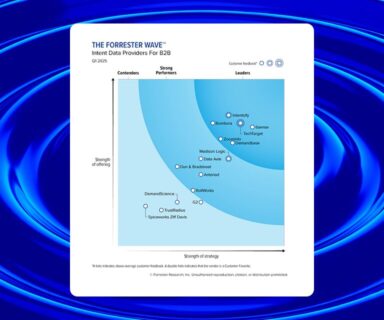 One of the more popular panels at our annual London ROI Summit is the CIO panel, and 2018 was no exception. Hosted by Bryan Glick, Editor-in-Chief of ComputerWeekly, this year’s panel featured two IT leaders from contrasting sectors – Not-for-profit and Big Oil. Despite being from vastly different industry sectors, there were a lot of commonalities in how the panelists research IT solutions and make decisions that ultimately lead to IT purchases.
One of the more popular panels at our annual London ROI Summit is the CIO panel, and 2018 was no exception. Hosted by Bryan Glick, Editor-in-Chief of ComputerWeekly, this year’s panel featured two IT leaders from contrasting sectors – Not-for-profit and Big Oil. Despite being from vastly different industry sectors, there were a lot of commonalities in how the panelists research IT solutions and make decisions that ultimately lead to IT purchases.
This year’s CIO panel included Avril Chester, Founder & CEO of Cancer Central and former IT Director, of Scope, and Mike McCormick, CIO of Vivo Energy Group.
To watch the full 34-minute video of the panel session, click here.
The purchase buying process is changing – use the right data sources to help you stay in front of it
According to Mike McCormick the buying process in no longer a linear one and it doesn’t focus on a single source of information. In the past it was more straightforward: (1) identifying the need, (2) find the product, (3) roll it out. But nowadays an IT technology purchase has to form a part of the existing IT ecosystem and the ecosystem is ever changing. Evaluating how to bring the product into his ecosystem seamlessly and with maximum functionality is a key component of the research and decision-making process and IT suppliers who help address this are the ones that end up on the purchase shortlist.
Another driver of change in the buying process stems from the root of the issue. As Mike notes, every solution purchase starts off by asking “What is the problem?”
- Is it a problem because something broke?
- Is it a problem because the business is changing?
- Is it a problem because a technology solves a problem you were never aware of?
Identifying the source of the problem – is it a reaction or is it a plan? – determines the urgency of the buy cycle and the prioritization of the purchase against his overall IT strategy and budget constraints.
Consider this:
In order for marketing and sales teams to be successful in reaching senior leaders and their buying teams, they need to be armed with the right data to help them:
- Identify when an account is in market based on the recency and velocity of activity – As Mike indicates, buyers must determine the root cause of their problem, an exercise which always involves research – done by senior leaders and/or their teams. The large majority of the time, this research starts with Google. As buyers typically perform 12+ searches before ending up on a vendor’s site (source: Think with Google), you won’t even see most of their buyer’s journey. If you wait for them to come to you, it is often too late. You must seek out sources of purchase intent insight that can identify active demand in the market that you cannot see in your own systems as it is happening. Identifying a ramp in content consumption around very specific topics will help you reach buyers in an active cycle rather than missing out on the shortlist.
- Leverage buyer insights to understand current purchase drivers and installed technology environment – The right sources of intent provide insights into topical interests, vendors being considered and the technology that companies currently have installed within their environment. As Mike notes, understanding how a product will fit in his current environment is critical to his purchase decision. Marketing and sales teams can use intent insight to create customized messaging and productive conversations to fit account and buyer needs.
Case study insight is key to helping IT Leaders build their vendor shortlist
“I’m not looking for a sales glossy from you,” says Avril Chester. “What I look for is a case study.” Comparative information is a significant part of the research she does during the buying process. “We do look at articles and go on to websites, but what I look for in the articles is something that compares stuff and gives me real information.” Trusted publisher websites (like ComputerWeekly), shared feedback on sites like LinkedIn, as well as CIO networking events offer a substantial source of research material. Ultimately, there are key questions that determine Avril’s interest in an IT supplier:
- What was the issue?
- How was it resolved?
- How did your IT partner help?
As mentioned above, buyers are doing a tremendous amount of research in independent environments to support purchase decisions. By the time they are ready to engage with you, they will assume you already understand their needs, which you will have with the right data sources. At this point, they don’t need questions from you or your salespeople, they are looking for answers in the form of case study or proof of concept insight. Be prepared to leverage case studies in late stage nurture and make sure sales is prepared to have fact-based engagements with senior buyers aligned to specific need and backed by success with similar clients.
Technology end-users play a significant role in the evaluation process – you must influence the entire buying team
This sentiment resonated across the board – the final purchase decision takes into consideration the needs and feedback from the technology end users and other business stakeholders. Mike’s team “directly engages with the end users of the technology and getting them in very early in the process because they understand their requirements far better than we do.”
So why are technology end-users having a say in the buying process? As Avril notes, “it’s not just a partnership with technology.” An IT supplier has to be the right fit for the organisation: does the IT supplier have the right values and approach to work with all the business teams? Will they be a good fit with the organisation? Mike says, “We’ve been quite arrogant as IT in the past to tell [our end users] how to do [their] job.” For IT solutions that affect his end users (both internal or customer-facing), Mike’s evaluation process evolved to gather their feedback first – essentially letting end users’ needs dictate IT solutions they research and evaluate.
Technology buying is a team decision-making process. Senior leaders may ultimately lead the process, but what sets companies apart in the shortlisting process is the ability to identify and influence each member of the buying team, including end-users or business counterparts. This is no easy task and you will want to look for 3rd party data partners that can help you identify when an account is in market, but also identify the named, active members of the buying team actually doing research on related topics and solutions like yours.
IT Leaders are looking for understanding, patience & honesty from potential IT suppliers
“Understand who we are as a company and what we’re about”, said Mike McCormick. Organizations that have done well are those that have done research on his company and have an understanding of who they are as a business and the complexities that they deal with. Avril echoed the same insight: “it’s about understanding who we are and going your homework.”
Be patient with the sales process. “Don’t call me when I don’t want you, but be there for me when I need you,” said Mike. “Understand that if we buy something from you this is going to be a relationship, not a sale,” so don’t push too hard from the get-go. IT suppliers who push incessantly are the ones that are dropped off the purchase shortlist: “Know when to back off,” says Mike.
Be honest about your capabilities. Both Mike and Avril were direct on this point! No single product will be perfect, but be open about where your strengths lie and how it can help the organisation. “We want an open and honest relationship” with IT suppliers, said Avril.
To hear directly about what IT leaders expect, you can view the entire session below:
In conclusion
There’s no point in the purchase process that will ensure a sale for you. Influencing the final decision maker and his or her team is often a long process and one that requires significant patience and insight. And being unprepared when you get an audience with senior leaders will most certainly lead to failure. This is why you need the right partners in place to help you find the buyers and reach them early and often with the right content and messaging fueled by insight.
To understand how TechTarget can help you more successfully influence senior IT leaders and buying teams, please reach out today.




